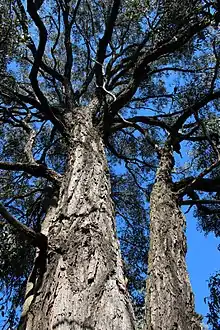Eucalyptus beyeriana
Eucalyptus beyeriana, commonly known as Beyer's ironbark,[2] is a small tree that is endemic to New South Wales. It has dark grey to black "ironbark", lance-shaped adult leaves, flower buds in groups of seven, white flowers and cup-shaped to conical or shortened spherical fruit. Its name is disputed with some authors considering it to be a synonym of Eucalyptus beyeri.
| Beyer's ironbark | |
|---|---|
 | |
| Eucalyptus beyeriana in Norfolk Reserve, Greenacre | |
| Scientific classification | |
| Kingdom: | Plantae |
| Clade: | Tracheophytes |
| Clade: | Angiosperms |
| Clade: | Eudicots |
| Clade: | Rosids |
| Order: | Myrtales |
| Family: | Myrtaceae |
| Genus: | Eucalyptus |
| Species: | E. beyeriana |
| Binomial name | |
| Eucalyptus beyeriana | |
| Synonyms[1] | |
|
Eucalyptus panda subsp. illaquens L.A.S.Johnson | |
Description
Eucalyptus beyeriana is a tree that grows to a height of 20 to 25 metres (66 to 82 ft) and forms a lignotuber. It has rough, dark grey to black "ironbark" on its trunk and branches. The leaves on young plants and on coppice regrowth are lance-shaped, 55–90 mm (2–4 in) long, 10–15 mm (0.4–0.6 in) wide and have a petiole. Adult leaves are lance-shaped, 70–140 mm (3–6 in) long, 7–20 mm (0.3–0.8 in) wide on a petiole 8–20 mm (0.3–0.8 in) long and the same dull green on both sides. The flower buds are arranged in groups of seven on a peduncle 5–10 mm (0.2–0.4 in) long, the individual buds on a pedicel 2–7 mm (0.08–0.3 in) long. Mature buds are oval to diamond-shaped, 4–5 mm (0.16–0.20 in) long, 2–3 mm (0.08–0.1 in) wide with a conical to rounded operculum that is narrower than the floral cup. Flowering occurs between August and November and the flowers are white. The fruit is a woody cup-shaped, conical or flattened spherical capsule 3–6 mm (0.12–0.24 in) long and wide on a pedicel 3–7 mm (0.12–0.28 in) long.[2][3][4][5]
Taxonomy and naming
Eucalyptus beyeriana was first formally described in 1990 by Lawrie Johnson and Ken Hill from a specimen collected near Wallacia. The description was published in the journal Telopea.[6]
Johnson and Hill considered that the species had been mistaken for E. beyeri, and that the type specimen of E. beyeri was a hybrid, with anthers intermediate between E. beyeriana and E. crebra, hence required a new name. Eucalyptus beyeri is now known as Eucalyptus × beyeri.[3][7] Ian Brooker disputes this interpretation and continues to use the name E. beyeri.[4]
The specific epithets (beyeriana and beyeri) honour George Beyer, an herbarium assistant at the Sydney Technological Museum who assisted Richard Thomas Baker, the author of E. beyeri.[3][8]
Distribution and habitat
Beyer's ironbark grows in woodland in infertile soil from Narrabri to Nowra.[2]
References
- "Eucalyptus beyeriana". Australian Plant Census. Retrieved 18 March 2019.
- Hill, Ken; Wilson, Paul G. "Eucalyptus beyeriana". Royal Botanic Garden Sydney. Retrieved 18 March 2019.
- Johnson, Lawrence; Hill, Kenneth (26 September 1990). "New taxa and combinations in Eucalyptus and Angophora (Myrtaceae)". Telopea. 4 (1): 83–84. doi:10.7751/telopea19904916.
- "Eucalyptus beyeri Beyer's ironbark". Euclid: Centre for Australian National Biodiversity Research. Retrieved 18 March 2019.
- Chippendale, George M. "Eucalyptus beyeri". Australian Biological Resources Study, Department of the Environment and Energy, Canberra. Retrieved 18 March 2019.
- "Eucalyptus beyeriana". APNI. Retrieved 18 March 2019.
- "Eucalyptus × beyeri". Australian Plant Census. Retrieved 18 March 2019.
- "Beyer, George (l865? - fl. 1920)". Australian National Herbarium. Retrieved 18 March 2019.